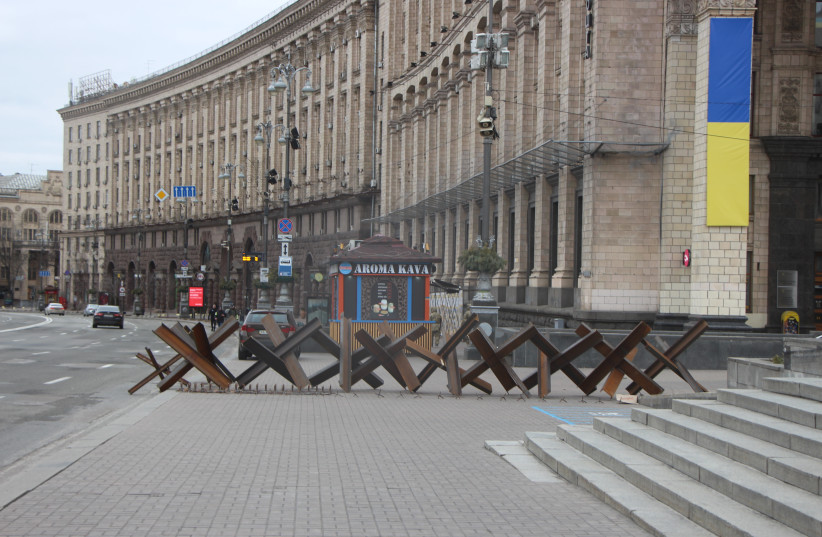KYIV – For the second time in a decade, barricades are going up at Kyiv’s Maidan Nezalezhnosti (Independence Square). During the protests of 2013-14, which began the domino process that eventually led to the Russian invasion currently underway, protesters here assembled makeshift wooden defenses against the security forces of then-president Viktor Yanukovych.
With Yanukovych’s departure, Maidan and its barricades became symbols of Ukrainian defiance against Russian interference and encroachment.
Today, the barriers being erected are of a harder, more durable nature. They will need to be. They are intended for defense against a regular army intending to imminently attempt a conquest of the city.
Russian troops are currently located just outside the northwestern suburbs of the Ukrainian capital. Fighting took place Friday night at Makarov and at the strategic Hostomel Airport (Antonov International Airport).
Ukrainian forces are trying to hold back the first elements of a huge Russian armored column that has been making its way from the Belarus border since February 24. The battle is a vital one. If these positions fall, the prospect that Kyiv could be encircled from the west becomes a realistic one.

According to a Ukrainian Interfax News Agency report on Friday, “There is shelling of residential areas of Irpin, Myrotska, Nemishayeve, Makariv, Bucha, Hostomel, Mykulychi. In Borodianka, as a result of shelling and airstrikes, the housing sector and infrastructure were severely damaged. There are periodic battles in Hostomel.” All these areas are located to the Ukrainian capital’s immediate northwest.
The new metal structures intended to impede the movement of armored vehicles are being placed by Ukrainian troops and volunteer forces at Maidan and other key crossing points in the city. One may assume that firing positions in the buildings adjoining the square have also been made ready.
If the Ukrainian defenses outside the city do not hold, these positions will be facing an onslaught from regular Russian forces in the period ahead. Putin has not forgotten the humiliation afforded his opponent at this same spot seven years ago. He will be seeking bloody revenge.
Overnight, piles of sand have been placed at intersections across the city. Throughout the day, young volunteers under the supervision of the security forces have been busily shoveling the sand into bags and preparing firing positions. Ukrainian flags are placed at the most prominent of these new posts. Some of those filling the sandbags are children.
THE MAIN Kyiv municipal building, adjoining Maidan, has been closed up. At an early stage of the Maidan protests, I remember, it was occupied by the protesters and became the location of raucous, lively debates, stretching on into the night. Now it is silent. Sandbags have been placed along all the entrances.
Kyiv has largely become a ghost town. Kreschatyk Street, the main thoroughfare of the city on which Maidan is located, is deserted. There are no accurate figures for the number of residents who have left Kyiv. But hardly anyone is present on its streets. Traffic other than speeding military or police vehicles is almost nonexistent. Apartments have their curtains drawn. All stores are closed other than groceries and pharmacies.
As of now, at least, there appear to be no major shortages of basic provisions. In two grocery stores that I visited, the shelves were not stacked, but vegetables, fruit, bread and processed meats were available. This will rapidly change, of course, in the event that the city becomes encircled.
Air-raid sirens sound at periodic intervals across the city. Kyiv has not yet faced large-scale missile attacks like those that have caused terrible destruction in Kharkiv, further east, and in a number of other Ukrainian cities.
Those residents who are still present in the capital have become somewhat blasé about the sirens. When they sound, some of the few people on the street rapidly make their way to the nearest building. Others, however, show no visible reaction, continuing on their way.
The spectacle of shut-down cities has become a familiar one over the last two years of the COVID-19 pandemic, of course. In Kyiv, the coronavirus feels like ancient history, an artifact from an earlier world.
The security forces deployed on the streets are jumpy and suspicious. On a number of occasions, I was stopped and engaged by uniformed members of the newly assembled Territorial Defense Forces in the Ukrainian language. When I replied in English, I was immediately allowed to continue on my way. They are looking for Russian speakers and telltale signs of a Russian accent in the pronunciation of certain words.
After ascertaining that I wasn’t a representative of the enemy, one of the volunteers, a middle-aged man, became friendly, offering the traditional exhortation that one hears everywhere here: “Slavy Ukraini – Heroyam Slava,” meaning Glory to Ukraine, glory to the heroes.
